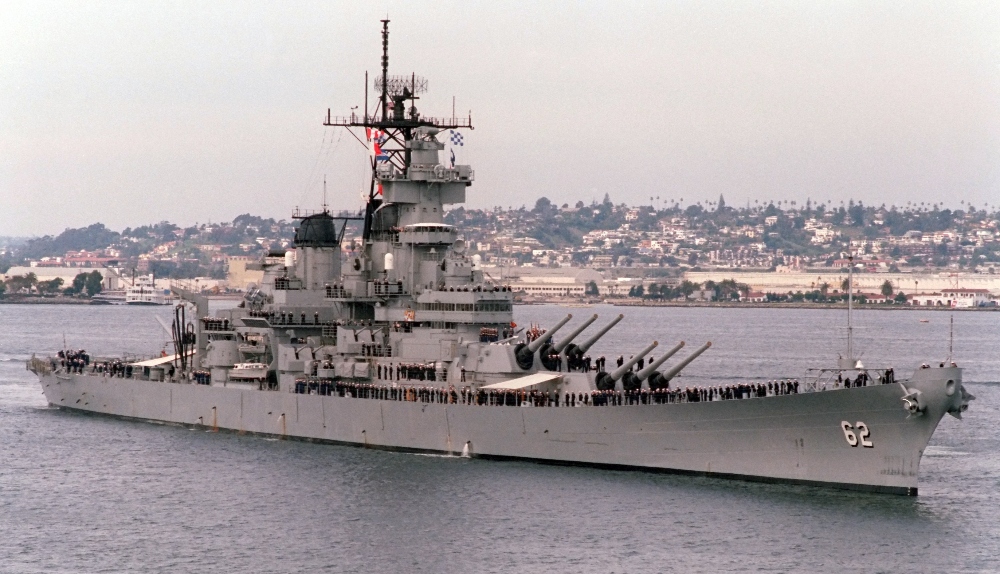The battleship New Jersey took a trip to Philadelphia recently for a facelift. The world’s most decorated battleship, the USS New Jersey, was towed to a Philadelphia dry dock where she will spend six months to get a paint job and cosmetic touches before returning to her museum status in Camden, New Jersey.
The short trip stirred memories for some of the sailors who gathered at a recent alumni festival. The battleship had been decommissioned twice and then returned to service to serve in Vietnam and the Middle East, adding to her service in the Pacific in World War II. The New Jersey was finally decommissioned and retired to become a museum in 1991.
One sailor remembered his recent experience: “While serving in Vietnam this ship saved us. The North Vietnamese had got in the middle, on the left was the Viet Cong and the Marines were on the right. The North Vietnamese started firing on us. Someone noticed and we stopped and we then called New Jersey to lay down fire; the middle there was just about 250 yards between us and the New Jersey blew the hell straight down the middle. I thanked the lord.”
That was a hint of the firepower of the last of the biggest American battleships that trace their design and history back three centuries. The New Jersey’s design is a direct descendant of the iron-clad Monitor, commissioned in 1862. The design was simple: a floating powered hull with a steel capped top and the biggest guns available, and there the similarities end.
The New Jersey was symbolically commissioned on the first anniversary of Pearl Harbor in 1942. She was built in Philadelphia’s shipyards, drawing parts from 36 states in a precursor of today’s standard of parceling out defense spending throughout the 50 states, a practice that encourages local Congressional Representatives to approve the ever-growing defense budgets. The 200,000 men and a few women built the New Jersey are also said to have helped Franklin Roosevelt’s win Pennsylvania in his 1940 presidential campaign.
The New Jersey can be considered a bargain by today’s standards. She cost today’s equivalent of $1.8 billion. No one builds battleships anymore, but the closest equivalent would be the Navy’s new aircraft carriers that cost in excess of $3 billion. The carriers weigh twice as much as the New Jersey, and both ships are speed demons. The aircraft carriers speed is likely close to the New Jersey’s top speed of a fraction under 50 miles per hour.
Battleships had a sea life of about 20 years. The New Jersey served for almost 50 years, making it the longest serving battleship ever. The battleship has three steel bottoms with watertight compartments among the 1,100 watertight compartments that can be isolated in an attack.
The New Jersey did battle in the two biggest encounters in naval history among the eight other Pacific Theatre battles in her logs. The two sea battles included the battle of the Philippine Sea, better known as the Marianas Turkey Shoot for the loss of Japanese fighters and bombers. The New Jersey shot down 37 enemy planes including some of the Kamikaze/suicide pilots aimed at her. None got through.
The biggest naval battle in history, the battle of Leyte Gulf, saw the New Jersey as the fleet command ship for Admiral William S. Halsey, colloquially known as “Bull Halsey.” Halsey’s “Bull” nickname came from his loud voice which seemed to have its own amplification system. In naval lore Halsey’s famous taunt of Japan goes down with John Paul Jones’ “I have not begun to fight” during a sea battle with a British Frigate in the American Revolutionary War. Old admirals also never die.
Discover more from Post Alley
Subscribe to get the latest posts sent to your email.

Of course, it was at Leyte Gulf that the Japanese successfully drew Halsey and the New Jersey out of position by sending a small portion of their fleet far to the north, figuring that Halsey would fall for the trick — which he did — and chase that decoy fleet, thereby allowing the main battle force of the Japanese to escape the bottleneck of a narrow strait in which Halsey, had he remained on station, would have kept them trapped. Great book on what happened next: “The Last Stand of the Tin Can Sailors.”
Or get moved from Bremerton to Honolulu.
As a kid growing-up in the mid-late-1960’s, a day trip to Bremerton and a walk on the deck of the Mighty Mo was always eagerly awaited! Also… 40 MPH (not 50).